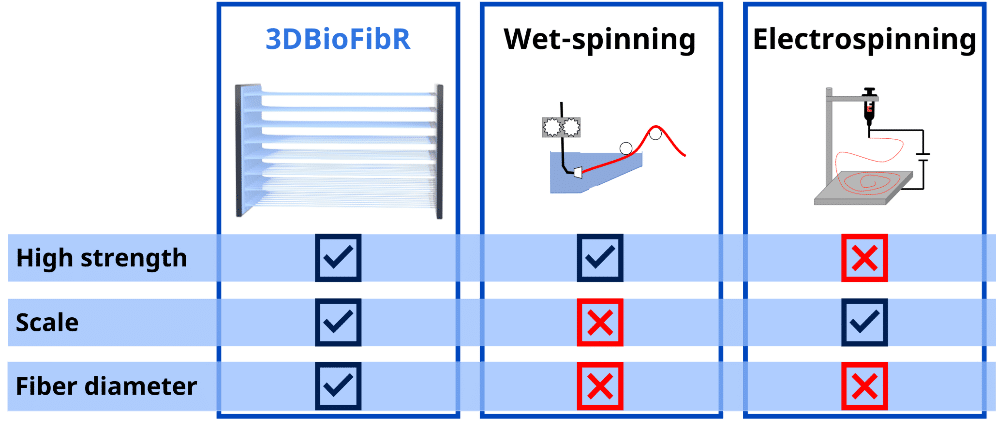Features
- GMP type I bovine collagen fibers that recapitulates natural strength of native collagen structures
- Induces cellular alignment, migration and elongation
- Capable of supporting 3D cellular growth
Applications
- 3D tissue culture - Physiologically relevant tissue culture environments with high consistency
- 3D bioinks - CollaFibR™ reinforced bioinks that move 3D bioprinting towards the clinic
- Contract tissue engineering - Customized collagen scaffolds to enable tissue model engineering
CollaFibR™ Scaffold for Cell Culture
CollaFibR™ scaffold is a highly consistent collagen fiber matrix. These matrices closely resemble the biomechanical and biochemical properties of natural collagen scaffolds, offering a more accurate representation of in-vivo conditions when studying cell and tissue models.
- Produced using GMP bovine type I collagen, and resemble natural collagen fiber structures
- Degradable with collagenase for easy cell extraction
- User friendly 12-well plate inserts
- Compatible with brightfield, epifluorescence, confocal and live cell microscopy
- UV sterilized and ready to use on receipt
- Available with fluorescent tag
μCollaFibR™- Additive for Bioinks and Hydrogels
μCollaFibR™ are engineered dry-spun 50 μm collagen fibers that increase the shape fidelity and biological relevance of bioprinted constructs. With exceptional chemical stability and ultra-fine 1-2 μm diameters, μCollaFibR™ is universally compatible with bioprinting materials and modalities.
- Produced using GMP bovine type I collagen, and resemble natural collagen fiber structures
- Increases mechanical strength and modulus of hydrogels in extension and compression
- Improves shape retention/durability for at least 28 days in cellular constructs
- Improves cellular viability and functionality within bioprinted cell constructs
Technology

With over 1000X the throughput of competing technologies, our dry-spinning approach is the first to spin collagen fibers at commercial scales.
By recreating the extensional flows that drive natural self-assembly processes, our fibers closely recapitulate the properties of natural collagen structures.
Strength Profile:
- Patented dry-spinning yields fibers with ultimate tensile strength at 248 MPa, 2-3 times stronger than native tendons.
- Electrospinning's use of volatile solvents and high shear forces limits mechanical and bioactivity features.
Scale:
- Wet spinning produces only 19m of fiber per hour, requiring large lab space. Electrospinning achieves rates of about 1000m per hour.
- Our dry spinning technology can produce 1000m per second.
Fiber Diameter:
- Collagen fibers in the body are typically 1-5 microns in diameter, crucial for cell attachment and directional cues.
- Wet spinning results in fibers with a diameter of 60 microns or more, hindering cell wrapping and directional cues. On the other hand, electrospinning creates fibers that are 0.2 microns or smaller, too fine for cell reliance.
- Dry spinning allows adjustment within the range of 0.2 to 20 microns, optimizing at 1-5 microns for excellent cell attachment, alignment, elongation and migration in tissue engineering.




